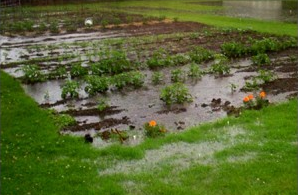Click below to listen to my Garden Bite radio show: Flooded plants
Audio PlayerMany of us have recently experienced some very wet weather. Rather unusual for August! Generally our lawns are like crispy toast, but this year, they’re actually green and we’re mowing at least once a week!

Flooding can literally drown your lawn. Air gaps that normally provide breathing room are filled with water. Grass roots die if they go without air for too long. Wet conditions also encourage fungus that can create dieback, damage and even kill your plants. We tend to forget that grass is a lot of small plants! If your lawn has sustained flooding, the most important thing is to avoid any traffic in the affected area. Too much traffic will create structural damage to your lawn, creating compacted soil that’s very difficult to repair. Before you attempt to tackle your lawn issues, make sure the soil has dried out sufficiently. You may need to reseed or even resod if you can.

Most perennial plants can withstand standing water for a few days but any more than that, the root structure will suffer. Never walk through the area while it’s saturated. You’ll compact the soil, taking out any oxygen that the soil needs and turn it into dirt clods. Another thing we sometimes forget about is making sure our containers have drainage holes. Some of those large ceramic containers don’t have much for drainage.


You can give them an advantage when planting, by providing perlite in the soil mix and/or placing foam blocks in the bottom.
If your veggie garden became a pond, let the soil dry and re-assess whether they’re worth saving. They may not be. Tomatoes may suffer from too much water. They’ll crack, either at the blossom or stem end. It’s called cat facing and results in ugly fruits that may not reach their full size. Generally, high soil moisture and high temperatures during a period of fast growth result in the condition. More on tomatoes tomorrow
